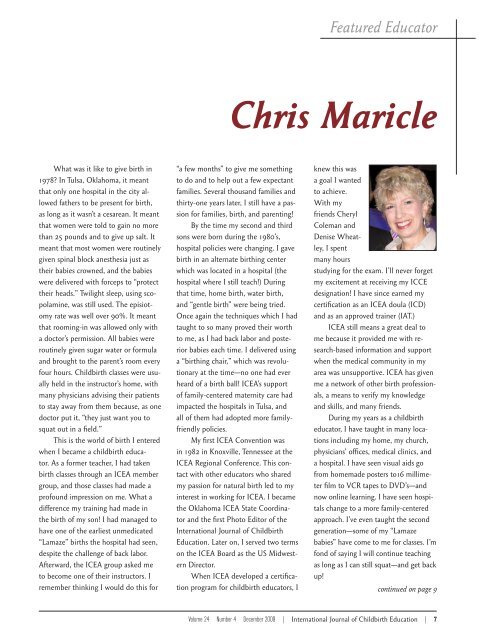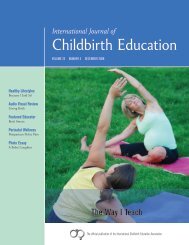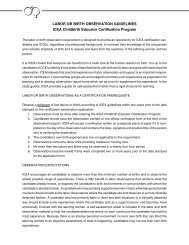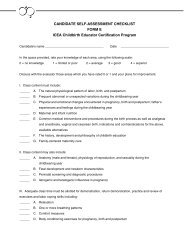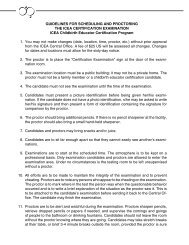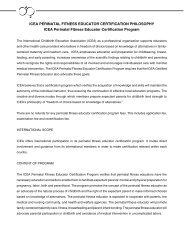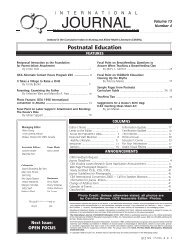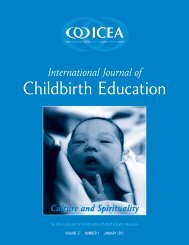Birth Day - International Childbirth Education Association
Birth Day - International Childbirth Education Association
Birth Day - International Childbirth Education Association
Create successful ePaper yourself
Turn your PDF publications into a flip-book with our unique Google optimized e-Paper software.
Featured Educator<br />
Chris Maricle<br />
What was it like to give birth in<br />
1978? In Tulsa, Oklahoma, it meant<br />
that only one hospital in the city allowed<br />
fathers to be present for birth,<br />
as long as it wasn’t a cesarean. It meant<br />
that women were told to gain no more<br />
than 25 pounds and to give up salt. It<br />
meant that most women were routinely<br />
given spinal block anesthesia just as<br />
their babies crowned, and the babies<br />
were delivered with forceps to “protect<br />
their heads.” Twilight sleep, using scopolamine,<br />
was still used. The episiotomy<br />
rate was well over 90%. It meant<br />
that rooming-in was allowed only with<br />
a doctor’s permission. All babies were<br />
routinely given sugar water or formula<br />
and brought to the parent’s room every<br />
four hours. <strong>Childbirth</strong> classes were usually<br />
held in the instructor’s home, with<br />
many physicians advising their patients<br />
to stay away from them because, as one<br />
doctor put it, “they just want you to<br />
squat out in a field.”<br />
This is the world of birth I entered<br />
when I became a childbirth educator.<br />
As a former teacher, I had taken<br />
birth classes through an ICEA member<br />
group, and those classes had made a<br />
profound impression on me. What a<br />
difference my training had made in<br />
the birth of my son! I had managed to<br />
have one of the earliest unmedicated<br />
“Lamaze” births the hospital had seen,<br />
despite the challenge of back labor.<br />
Afterward, the ICEA group asked me<br />
to become one of their instructors. I<br />
remember thinking I would do this for<br />
knew this was<br />
a goal I wanted<br />
to achieve.<br />
With my<br />
friends Cheryl<br />
Coleman and<br />
Denise Wheatley,<br />
I spent<br />
many hours<br />
studying for the exam. I’ll never forget<br />
my excitement at receiving my ICCE<br />
designation! I have since earned my<br />
certification as an ICEA doula (ICD)<br />
and as an approved trainer (IAT.)<br />
ICEA still means a great deal to<br />
me because it provided me with research-based<br />
information and support<br />
when the medical community in my<br />
area was unsupportive. ICEA has given<br />
me a network of other birth professionals,<br />
a means to verify my knowledge<br />
and skills, and many friends.<br />
During my years as a childbirth<br />
educator, I have taught in many locations<br />
including my home, my church,<br />
physicians’ offices, medical clinics, and<br />
a hospital. I have seen visual aids go<br />
from homemade posters to16 millimeter<br />
film to VCR tapes to DVD’s—and<br />
now online learning. I have seen hospitals<br />
change to a more family-centered<br />
approach. I’ve even taught the second<br />
generation—some of my “Lamaze<br />
babies” have come to me for classes. I’m<br />
fond of saying I will continue teaching<br />
as long as I can still squat—and get back<br />
up!<br />
“a few months” to give me something<br />
to do and to help out a few expectant<br />
families. Several thousand families and<br />
thirty-one years later, I still have a passion<br />
for families, birth, and parenting!<br />
By the time my second and third<br />
sons were born during the 1980’s,<br />
hospital policies were changing. I gave<br />
birth in an alternate birthing center<br />
which was located in a hospital (the<br />
hospital where I still teach!) During<br />
that time, home birth, water birth,<br />
and “gentle birth” were being tried.<br />
Once again the techniques which I had<br />
taught to so many proved their worth<br />
to me, as I had back labor and posterior<br />
babies each time. I delivered using<br />
a “birthing chair,” which was revolutionary<br />
at the time—no one had ever<br />
heard of a birth ball! ICEA’s support<br />
of family-centered maternity care had<br />
impacted the hospitals in Tulsa, and<br />
all of them had adopted more familyfriendly<br />
policies.<br />
My first ICEA Convention was<br />
in 1982 in Knoxville, Tennessee at the<br />
ICEA Regional Conference. This contact<br />
with other educators who shared<br />
my passion for natural birth led to my<br />
interest in working for ICEA. I became<br />
the Oklahoma ICEA State Coordinator<br />
and the first Photo Editor of the<br />
<strong>International</strong> Journal of <strong>Childbirth</strong><br />
<strong>Education</strong>. Later on, I served two terms<br />
on the ICEA Board as the US Midwestern<br />
Director.<br />
When ICEA developed a certification<br />
program for childbirth educators, I continued on page 9<br />
Volume 24 Number 4 December 2009 | <strong>International</strong> Journal of <strong>Childbirth</strong> <strong>Education</strong> | 7


